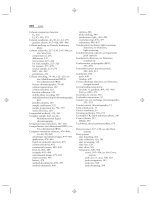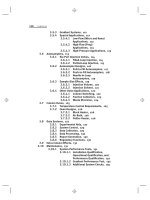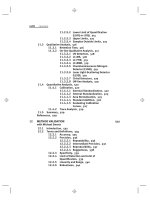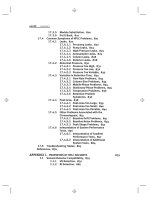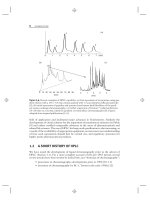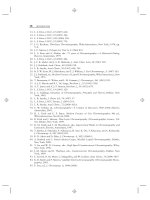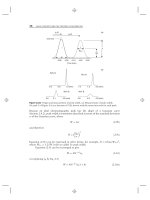Introduction to Modern Liquid Chromatography, Third Edition part 39 pptx
Bạn đang xem bản rút gọn của tài liệu. Xem và tải ngay bản đầy đủ của tài liệu tại đây (228.75 KB, 10 trang )
336 IONIC SAMPLES: REVERSED-PHASE, ION-PAIR, AND ION-EXCHANGE CHROMATOGRAPHY
sorbed TBA
+
. For examples of these generalizations, see the discussion of Figure 7.12
in the following section.
7.4.1.2 Ion-Pair Reagent: Concentration and Type
It is possible to continuously vary the nature of retention, from RPC retention as
in Figure 7.11a to IPC retention as in Figure 7.11b, by varying the concentration
of the IPC reagent in the stationary phase. The concentration of the reagent in
the stationary phase can be varied by changing its concentration in the mobile
phase. We will use the example of Figure 7.12 to illustrate the effect of IPC reagent
concentration on solute retention. In this example a tetrabutylammonium phosphate
IPC reagent (TBA
+
) is assumed initially, with a C
8
column. Consider first the
equilibrium uptake of TBA
+
≡ R
+
by the stationary phase (solid curve for TBA
+
at the bottom of Fig. 7.12a). The concentration of R
+
in the stationary phase [R
+
]
s
is plotted against its concentration in the mobile phase [R
+
]
m
, showing a continued
increase in stationary phase concentration as [R
+
]
m
increases, until the stationary
phase becomes saturated with R
+
(with no further change in concentration of R
+
in
the stationary phase for further increase in [R
+
]
m
). The form of this plot is typical
of the uptake of sample or other molecules by a RPC column, when the sample
concentration in the mobile phase is increased (so-called Langmuir adsorption;
Section 15.3.1.1 and Eq. 15.1).
Two different plots of [R
+
]
s
versus [R
+
]
m
are shown in Figure 7.12a: a solid
curve for TBA
+
, and a dashed curve for tetraethylammonium (TEA
+
). Because
TBA
+
is the more hydrophobic of the two IPC reagents, it is retained by the
stationary phase more strongly and saturates the column at a lower concentration
of R
+
in the mobile phase. The extent of ion-pairing will depend on the fractional
saturation of the stationary phase, and this is seen to depend on (1) the IPC reagent
concentration in the mobile phase and (2) the hydrophobicity or retention of the IPC
reagent. IPC reagent hydrophobicity and retention will increase for an increase in
the carbon number of the reagent (number of CH
3
-plusCH
2
- groups in the reagent
molecule), making TBA
+
(with 16 carbons) more hydrophobic and more retained
than TEA
+
(with 8 carbons). We also see in Figure 7.12a (dotted lines) that a larger
concentration y of a less hydrophobic reagent (TEA
+
) can result in the same uptake
[R
+
]
s
of reagent by the column as a lower concentration x of a more hydrophobic
IPC reagent (TBA
+
), consequently resulting in similar ion pairing and retention of
the solute A
−
(e.g., see later Fig. 7.15 and the accompanying discussion).
Consider next the change in sample retention k as the IPC reagent concentration
increases (Fig. 7.12b). Assume a fully ionized acidic solute RCOO
−
, whose RPC
retention is essentially zero for some value of %B. When an IPC reagent is added to
the mobile phase, k will increase initially as a result of the interaction of RCOO
−
with R
+
in the stationary phase. Once the stationary phase is saturated with R
+
,
no further increase in retention of RCOO
−
can occur; however, a further increase
in the mobile-phase concentration of R
+
isaccompaniedbyanincreaseinthe
concentration of its counter-ion X
−
(e.g., H
2
PO
−
4
). An increase in the H
2
PO
−
4
concentration [H
2
PO
−
4
]
m
then competes with RCOO
−
for ion-exchange retention
(Eq. 7.9a), leading to a gradual decrease in k as shown in Figure 7.12b. Thus
preferred concentrations of the IPC reagent in the mobile phase should not exceed a
value that begins to saturate the column—so that solute retention then declines.
7.4 ION-PAIR CHROMATOGRAPHY (IPC) 337
(b) Retention of ionized acid RCOO
−
vs concentration of R
+
in mobile phase [R
+
]
m
mobile phase
stationary phase
(a) Uptake of IPC reagent R
+
by the stationary phase
++
TBA
+
H
2
PO
4
+
TBA
+
H
2
PO
4
−
TBA
+
H
2
PO
4
−
TEA
+
TBA
+
H
2
PO
4
+
C
8
C
8
C
8
C
8
C
8
C
8
C
8
C
8
C
8
C
8
C
8
C
8
C
8
C
8
C
8
TBA
+
RCOO
−
RCOO
−
k
[R
+
]
m
[R
+
]
m
[R
+
]
s
IPC
retention
competition
with H
2
PO
4
−
x
y
Figure 7.12 Representation of the uptake of IPC reagent by the column, and its effect on
solute retention.
7.4.1.3 Simultaneous Changes in pH and Ion Pairing
When mobile-phase pH and the concentration of the IPC reagent are varied simulta-
neously, a remarkable control is possible over retention range and relative retention
for ionic samples (as anticipated by Fig. 7.10). This can be visualized for an indi-
vidual solute from the plots of k against either pH or IPC reagent concentration
in Figures 7.11b and 7.12b. Now consider that similar plots will result for other
solutes, but with the possibility of different dependencies of k on pH and IPC
reagent concentration. An example of separation as a function of change in both
338 IONIC SAMPLES: REVERSED-PHASE, ION-PAIR, AND ION-EXCHANGE CHROMATOGRAPHY
02
Time (min)
02
Time (min)
02
Time
(
min
)
B
HA
1
+
HA
2
N
B
N
HA
2
HA
2
HA
1
HA
1
N
B
(a)
pH-2.5
RPC
(b)
pH-5.0
RPC
(c)
pH-7.5
RPC
02
Time (min)
HA
2
HA
1
N
B
pH-5.0
IPC (R
−
)
(d)
Figure 7.13 Example of the separation of an ionic sample where both mobile-phase pH and
IPC reagent concentration are varied. Sample: B, pseudoephedrine; N, glycerol guaicolate
(a neutral compound, shaded); HA
1
, sodium benzoate; HA
2
, methylparaben (a phenol).
Conditions: 150 × 4.6-mm C
8
column (5-μm particles); 30% methanol-citrate buffer with
130-mM hexane sulfonate for the IPC mobile phase; 50
◦
C; 3.0 mL/min. Adapted from [51].
mobile-phase pH and IPC reagent concentration is illustrated in Figure 7.13. The
sample consists of a neutral compound (N; shaded peak), a weakly basic compound
(B), an acidic compound (HA
1
) and a weakly acidic compound (HA
2
). Three separa-
tions were carried out (Fig. 7.13a–c), with pH varying but without any IPC reagent
in the mobile phase. The dotted lines track changes in relative retention for each
peak. A fourth separation (Fig. 7.13d) uses a mobile phase with intermediate pH
plus added hexane sulfonate (R
−
) as the IPC reagent.
Consider first the retention of the neutral compound N (shaded peak). As pH is
varied in the separations of Figure 7.13a–c, there is little change in its retention—as
expected. When the IPC reagent (R
−
) is added in Figure 7.13d, the retention of
N is reduced as a result of partial blockage of the stationary-phase surface by sorbed
R
−
. Next consider the retention of weakly basic compound B. Its retention increases
for pH
>
5, and the addition of IPC reagent in Figure 7.13d (pH = 5.0), increases
retention even more (the arrows in Fig. 7.13d indicate changes in retention vs. the
separation of Fig. 7.13b [same pH]). The various changes in the retention of B are
the result of a decreasing ionization of this basic solute (BH
+
→ B) as pH increases,
while addition of the IPC reagent R
−
confers a negative charge on the column that
attracts the positively charged BH
+
. Finally, acidic compounds HA
1
and HA
2
show
decreased retention with increase in pH, and their retention is further decreased by
7.4 ION-PAIR CHROMATOGRAPHY (IPC) 339
the addition of the IPC reagent R
−
(because of ionic repulsion between A
−
and
R
−
in the stationary phase, plus partial coverage of the stationary phase by sorbed
molecules of R
−
).
Finally, we can see that as a result of change in both mobile-phase pH and
IPC reagent concentration, major changes in relative retention result for each of the
conditions of Figure 7.13:
Low pH, no ion pairing (a):
B < N < AH
1
= AH
2
Intermediate pH, no ion pairing (b):
B < HA
1
< N < HA
2
High pH, no ion pairing (c):
HA
1
< N < B < HA
2
Intermediate pH, ion pairing, d:
HA
1
< N < HA
2
< B
The best separation for this sample is seen in Figure 7.13d ,usinganIPC
reagent at pH-5.0.
To summarize, the concentration and type of the IPC reagent can be varied for
systematic changes in ion pairing, with predictable effects on retention range and
relative retention. When an anionic IPC reagent (e.g., an alkylsulfonate) is added to
the mobile phase, the retention of ionized basic compounds will be increased, and
the retention of neutral and (especially) acidic compounds will be decreased. When
a cationic IPC reagent (e.g., a tetraalkylammonium salt) is used, the retention of
ionized acidic compounds will be increased, while that of neutral and (especially)
basic solutes will be decreased. These changes in retention will be greater for larger
concentrations of the IPC reagent in the mobile phase. Changes in mobile-phase pH
that increase the ionization of a compound will increase the effect of the IPC reagent
on separation.
7.4.2 Method Development
IPC method development is similar to that for the RPC separation of ionic samples
(Section 7.3.3). The same seven method-development steps listed in Figure 6.21a
for neutral samples still apply, with only step 3 (‘‘choosing separation condition’’)
differing for IPC separation. As in the case of RPC method development, the choice
of separation conditions for IPC includes the following steps:
1. choose starting conditions
2. select %B for 1 ≤ k ≤ 10 (with IPC reagent in the mobile phase)
3. adjust conditions for improved selectivity and resolution
340 IONIC SAMPLES: REVERSED-PHASE, ION-PAIR, AND ION-EXCHANGE CHROMATOGRAPHY
4. vary column conditions for best compromise between resolution and run
time
In most cases, an RPC separation (without IPC reagent present) will have
been attempted initially, including a study of changes in mobile-phase pH (our
recommendation). Consequently it is likely that different peaks in the chromatogram
can be assigned as neutrals, acids, or bases (as in the example of Fig. 7.3). This
approach also explores the possibility of a non-IPC, RPC separation—with a simpler
mobile phase and one less likely to have IPC-related problems (Section 7.4.3). Even
when IPC separation is anticipated at the beginning of method development,
initial experiments should proceed in similar fashion as described in Section 7.3.3
(development of an RPC method for ionic samples)—without addition of the IPC
reagent to the mobile phase. The latter experiments will define the approximate
%B required for an acceptable retention range (e.g., 1 < k < 10) or at least a %B
value for an average value of k that falls within this range. As in the case of
RPC method development for ionic samples, only steps 1 and 3 above differ for
IPC.
7.4.2.1 Choice of Initial Conditions (Step 1)
The requirement of both a buffer and an IPC reagent in the mobile phase may favor
the use of methanol as B-solvent, because of the greater solubility of these additives
in methanol (TFA and HFBA, however, have adequate solubility in acetonitrile but
are weaker IPC reagents). If acetonitrile is used in preliminary RPC experiments (our
recommendation), and if solubility problems are subsequently encountered with this
solvent, methanol can be substituted (guided by the solvent strength nomograph
of Fig. 6.11). In most cases an alkylsulfonate will be chosen as IPC reagent for
samples that contain basic compounds, while a tetraalkylammonium salt will be
used for acidic samples. When both acids and bases are present in the sample,
either type of IPC reagent may prove useful, but it is not recommended to add both
reagents to the mobile phase. The reagents tend to ion-pair with each other, with
cancellation of their net effect on separation; the use of two IPC reagents would also
complicate method development. An alkylsulfonate is preferred when it is necessary
to selectively increase the retention of basic solutes, while a tetraalkylammonium
salt can increase the retention of acidic solutes.
For mixtures of acids and bases, a low-pH mobile phase plus an alkylsulfonate
IPC reagent is a good starting point because the pH suppresses ionization of acids
and the IPC reagent retains the bases. The final choice of one or the other of
these reagents can be determined from information acquired during preliminary
RPC experiments; specifically, retention as a function of mobile-phase pH. Both
sulfonates and quaternary ammonium salts can be used with UV detection at a
wavelength of 210 nm or higher.
The discussion of Section 7.4.1.2 and Figure 7.12a suggest that similar
separations can be obtained with different concentrations of two different alkyl-
sulfonates (or quaternary ammonium salts), for example, a lower concentration
of a C
8
-sulfonate, or a higher concentration of a C
6
-sulfonate. This is generally
correct [47, 48], but the practical question is then: Which IPC reagent and which
concentration should be used for an initial IPC experiment? One study [49] has
provided an approximate answer to this question, as summarized in Figure 7.14.
7.4 ION-PAIR CHROMATOGRAPHY (IPC) 341
100
10
1
100806040200
% MeOH
100806040200
% MeOH
C
4
(C
1
)
4
(C
2
)
4
(C
3
)
4
(C
4
)
4
(C
5
)
4
C
6
C
8
C
10
C
12
100
10
(a) Recommended concentrations of different alkyl sulfonates
(b) Recommended concentrations of different tetraalkylammonium salts
[R
−
]
m
[R
+
]
m
Figure 7.14 Recommended IPC reagents and concentrations as a function of mobile-phase
%B: (a) sulfonate IPC reagent; (b) quaternary ammonium IPC reagent. Adapted from [49].
Conditions corresponding to shaded regions are not recommended.
The recommended starting concentrations of different sulfonates (Fig. 7.14a)or
quaternary ammonium salts (Fig. 7.14b) are plotted against %-MeOH in the mobile
phase. For example, given a mobile phase of 40%B, and the planned addition
of an alkylsulfonate as IPC reagent, Figure 7.14a suggests that either 75 mM of
octanesulfonate (C
8
) or 15 mM of decanesulfonate (C
10
) would be a suitable starting
concentration. Alternatively, for the use of a tetraalkylammonium salt (Fig. 7.14b)
with a mobile phase of 40% B, either 70 mM of tetrabutylammonium (C
4
)or
20 mM of tetrapentylammonium (C
5
) is recommended. It is desirable to select an
initial concentration of the IPC reagent between 5 and 100 mM, as indicated by the
unshaded regions of Figure 7.14a, b.
The (initial) concentrations recommended in Figure 7.14 will provide about
1
/
3
surface coverage by the reagent. Varying the concentration up or down from
this initial value then allows a significant change in reagent uptake by the column,
with predictable changes in relative retention (Section 7.4.1.2). If acetonitrile is used
342 IONIC SAMPLES: REVERSED-PHASE, ION-PAIR, AND ION-EXCHANGE CHROMATOGRAPHY
as B-solvent for IPC separation, Figure 7.14 can still be used for estimates of IPC
reagent type and concentration, but the equivalent value of %B for MeOH should
be (very approximately) doubled. Thus, if the mobile phase consists of 20% ACN,
a value of 2 × 20 ≈ 40% MeOH should be used in Figure 7.14 [50] for the purpose
of selecting an IPC reagent and its initial concentration. That is, acetonitrile is a
stronger solvent than methanol, so a lower value of %-ACN is equivalent to a higher
value of %-MeOH.
An example that illustrates some of the principles above is provided by
Figure 7.15, where the separation of a mixture of water-soluble vitamins is exam-
ined as a function of IPC reagent concentration and type. As the sample includes
compounds with both acidic (anionic) and basic (cationic) character, either a
sulfonate or quaternary ammonium salt could be used for ion pairing. If a sul-
fonate is selected, Figure 7.14 suggests for this mobile phase (15% methanol-buffer
[pH-3.2]) the use of hexane, heptane, or octane sulfonate as IPC reagent. Sepa-
rations of the sample with varying concentrations of hexane sulfonate are shown
in Figure 7.15a–c. Peaks 1 to 3 exhibit little change in retention with changing
reagent concentration and can be regarded as effectively neutral (neither anionic
or cationic). Peaks 4 and 6 show an increase in retention as the reagent concen-
tration increases, so these peaks must be cationic (protonated bases or quaternary
5 mM 1.3 mM
10 mM 2.5 mM
20 mM 5 mM
hexane sulfonate heptane sulfonate
02468
Time (min)
02468
Time (min)
Time (min)
Time
(
min
)
Time
(
min
)
02468
Time (min)
02468
4
5
7
6
4
5
6
7
1
2
3
4
5
6
7
4
5
7
6
0 2 4 6 8 0 2 4 6 8 10 12
4
+
5
7
6
4
+
5
7
6
(a)
(b)
(c)
(d)
(e)
(f )
Figure 7.15 IPC separation of a sample of water-soluble vitamins as a function of IPC reagent
concentration and type. Sample: 1, ascorbic acid; 2,niacin;3, niacinamide; 4, pyridoxine;
5, folic acid; 6,thiamine;7, riboflavin. Conditions; 83 × 4.6-mm C
8
column (3-μmparti-
cles); 15% methanol- buffer (pH-3.2); 35
◦
C; 2.0 mL/min. Chromatograms recreated from
data in [48].
7.4 ION-PAIR CHROMATOGRAPHY (IPC) 343
ammonium compounds). Similarly peaks 5 and 7 exhibit decreased retention as
the reagent concentration increases and are therefore anionic (ionized acids). From
these initial experiments (Fig. 7.15a–c), it appears that a hexane sulfonate concen-
tration of 6 to 7 mM would provide maximum resolution of peaks 4 to 7 (placing
peak 5 midway between peaks 4 and 6, but without moving peak 7 too close to
peak 6).
Figure 7.15d–f shows corresponding separations with heptane sulfonate as
IPC reagent; in each case, the reagent concentration is reduced fourfold compared
to separations with hexane sulfonate as IPC reagent. The resulting separations for
Figure 7.15a and d,b and e,orc and f, are each quite similar (but not identical).
That is, essentially the same separation can be achieved for this sample with a lower
concentration of a more hydrophobic IPC reagent, but the selectivity may not be
exactly the same. The arbitrary substitution of one IPC reagent for another in a
previously developed method is therefore not recommended.
Inorganic reagents (or ‘‘chaotropes’’) such as ClO
−
4
,BF
−
4
, and PF
−
6
have
also been used in IPC [52, 53], in place of the usual alkane sufonates. Because of
the lesser retention of inorganic reagents, it is likely that the retention mechanism is
based on Equation (7.9)— ion-pairing in the mobile phase—rather than Equation
(7.9a)—sorption of the IPC reagent. Chaotropes are advantageous in being better
suited for gradient elution (less baseline noise and drift) and are more soluble in
mobile phases with larger values of %B. The relative ion-pairing strength of various
anions (including both buffers and IPC reagents) increases in the following order:
H
2
PO
−
4
< HCOO
−
< CH
3
SO
−
3
< Cl
−
< NO
−
3
CF
3
COO
−
< BF
−
4
< ClO
−
4
< PF
−
6
Only the last four anions are useful for IPC. Because inorganic IPC reagents
(chaotropes) are less strongly retained by the stationary phase, this can mean faster
equilibration of the column when changing the mobile phase (Section 7.4.3.2). The
effect of chaotropes in altering the retention of protonated bases appears much more
pronounced for acetonitrile as B-solvent, compared to methanol or tetrahydrofuran
[54].
7.4.2.2 Control of Selectivity (Step 3)
The separation conditions available for the control of selectivity in IPC include:
•pH
• IPC reagent type (sulfonate, quaternary ammonium salt, chaotrope)
• IPC reagent concentration
• solvent strength (%B)
• solvent type (ACN, MeOH, etc.)
• temperature
• column type
• buffer type and concentration
344 IONIC SAMPLES: REVERSED-PHASE, ION-PAIR, AND ION-EXCHANGE CHROMATOGRAPHY
Despite the large number of variables that can affect selectivity in IPC, usually only
a few of these conditions need to be investigated during method development. Fur-
thermore the effects on retention of several of the conditions above are interrelated.
Thus a change in mobile-phase pH will, in some cases, give similar results as a
change in IPC reagent concentration; for example, an increase in pH or an increase
in the concentration of an alkylsulfonate IPC reagent will in each case result in an
increase in the retention of basic solutes (and a decrease in retention for acids). Also
we have seen that the primary effect of a change in %B or temperature may be
the result of associated changes in the ‘‘effective’’ pH of the mobile phase—hence
providing similar changes in relative retention as for a change in mobile-phase pH.
Other examples of this kind are noted below.
Mobile Phase pH and IPC Reagent Type or Concentration. The combined effects
of these conditions on IPC separation were discussed in detail above (Section 7.4.1),
and are best investigated first during IPC method development. It is more convenient
to vary the concentration of the IPC reagent (as in Fig. 7.15a–c), than to change the
IPC reagent (as in Fig. 7.15f vs. a).
Solvent Strength. When %B is varied for the RPC separation of ionic samples
(Section 7.3.2.2; Fig. 7.7), changes in both absolute and relative retention can be
expected. In some cases these change in retention can be related to corresponding
changes in the ‘‘apparent’’ pH of the mobile phase (or values of pK
a
for the solute;
Section 7.2.3). Corresponding changes in relative retention with %B should also
occur for IPC separation, but with an added feature. Thus, if %B is increased,
the uptake of the IPC reagent by the column will decrease, just as for the case of
sample molecules. Consequently a change in %B should lead to predictable changes
in relative retention for peaks that are strongly affected by ion pairing. An example
is presented in Figure 7.16 for the same sample of Figure 7.10. An initial separation
with 40% MeOH and octanesulfonate as IPC reagent is shown in Figure 7.16a,with
the four protonated bases (X, X
1
–X
3
) distinguished as shaded peaks (remaining
peaks correspond to either neutral or acidic solutes). When the mobile phase is
changed to 45% MeOH in Figure 7.16b, and 50% MeOH in Figure 7.16c,the
retention of all peaks decreases (solvent strength effect), but the four bases become
even less retained relative to the remaining neutral and acidic peak (they move
toward the front of the chromatogram). This behavior is predictable, as the increase
in %MeOH will result in a decrease in the retention of the IPC reagent (R
−
)by
the stationary phase. The reduced concentration of R
−
in the stationary phase
means a reduction in ion-pairing for the cationic species X, X
1
–X
3
, and therefore
their reduced retention—apart from the general decrease in retention for all peaks
when %MeOH is increased. The variation of %MeOH in this example shows the
exceptional power of a change in %B in IPC to affect band spacing and resolution
(note the optimized separation for 45% MeOH in Fig. 7.16b).
Solvent Type. A change in solvent type usually leads to changes in IPC
selectivity, for either neutral samples (Section 6.3.2; Fig. 6.9) or (especially) ionic
samples (Section 7.3.2.3). Because of the added effect of the B-solvent on the
uptake of IPC reagent by the column, a change of solvent type in IPC can result
in even larger changes in selectivity than in RPC. Figure 7.17 provides a striking
7.4 ION-PAIR CHROMATOGRAPHY (IPC) 345
HB
B
X
+
MP
PP
024681012141618
Time (min)
0246810
Time (min)
0246
Time (min)
HB
B
X
X
1
X
1
X
1
X
2
X
2
X
2
X
3
X
3
X
3
PP
MP
(a)
(b)
(c)
40% MeOH
45% MeOH
50% MeOH
HB
B
MP
X
PP
Figure 7.16 Solvent-strength selectivity in IPC separation. Sample and conditions as in Figure
7.10b, except for indicated % methanol. Peaks for protonated bases X, X1–X3 shaded.
Adapted from [45].
example of solvent-type selectivity in IPC, for a change of B-solvent from MeOH in
Figure 7.17a toACNinFigure7.17b, with use of the solvent nomograph of Figure
6.11. A combined variation of mobile-phase pH, IPC reagent concentration, and
solvent type should prove especially effective for the separation of challenging ionic
samples [48, 50].
Temperature. A change in temperature for IPC should also have a pronounced
effect on relative retention. Temperature will alter the amount of IPC reagent held by
the column. For this reason temperature control during IPC separation is especially
important.
Column Type and Buffer. We have seen that column type can have a major
effect on selectivity in RPC separations of ionic samples, and it seems likely that this
will also be true for IPC separation. However, the partial coverage of the stationary
phase surface by IPC reagent may tend to mask the contribution of the column
per se to sample retention. In view of the many other ways in which selectivity can
be controlled in IPC, the use of column type for this purpose should not be a first
choice, nor is it likely to be especially promising. Likewise the effect of buffer type
and concentration on IPC separation can be significant, but larger, more predictable
changes in selectivity can be obtained by varying pH, %B, temperature, and/or the
type and concentration of the IPC reagent.
